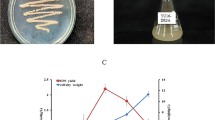Abstract
Alteromonas macleodii subsp. fijiensis biovar deepsane is a deep-sea ecotype exopolysaccharide-producing bacteria isolated from the polychaete annelid Alvinella pompejana. The high molecular weight biopolymer HYD657 produced by this strain, is the first marine exopolysaccharide (EPS) to be commercialized for cosmetic use. Depolymerization methods are necessary to elucidate the complete structure of this EPS and to generate potentially bioactive oligosaccharides. Enzymatic methods are useful for elucidating polysaccharide structure because they specifically cleave glycosidic bonds and do not require harsh chemical conditions. The HYD657 EPS is structurally complex and no commercially available enzymes are able to effectively degrade it. Here, we present the first results on the endogenous enzymatic depolymerization of a marine EPS of biotechnological interest by the producing strain. Enzymatic activity was detected in the bacterial lysate and was able to decrease the apparent molecular size of the EPS, releasing mainly oligosaccharides. The reduced form of the native polysaccharide showed a slightly modified osidic composition, particularly in terms of molar ratio. Several exoglycosidase activities were measured in the bacterial lysate using paranitrophenyl-osides.





Similar content being viewed by others
References
Badel S, Bernardi T, Michaud P (2011) New perspectives for Lactobacilli exopolysaccharides. Biotechnol Adv 29:54–66
Bakkevig K, Sletta H, Gimmestad M, Aune R, Ertesvåg H, Degnes K, Christensen BE, Ellingsen TE, Valla S (2005) Role of the Pseudomonas fluorescens alginate lyase (AlgL) in clearing the periplasm of alginates not exported to the extracellular environment. J Bacteriol 187:8375–8384
Bradford MM (1976) A rapid and sensitive method for the quantitation of microgram quantities utilizing the principle of protein dye binding. Anal Biochem 72:248–254
Cambon-Bonavita MA, Raguenes G, Jean J, Vincent P, Guézennec J (2002) A novel polymer produced by a bacterium isolated from a deep-sea hydrothermal vent polychaete annelid. J Appl Microbiol 93(2):310–315
Colliec-Jouault S, Chevolot L, Helley D, Ratiskol J, Bros A, Sinquin C, Roger O, Fischer AM (2001) Characterization, chemical modifications and in vitro anticoagulant properties of an exopolysaccharide produced by Alteromonas infernus. Biochem Biophys Acta 1528(2–3):141–151
Courtois A, Berthou C, Guézennec J, Boisset C, Bordron A (2014) Exopolysaccharides isolated from hydrothermal vent bacteria can modulate the complement system. PLoS ONE. doi:10.1371/ 0094965
Driskill LE, Bauer MW, Kelly RM (1999) Synergistic interactions among β-laminarinase, β-1,4-glucanase, and β-glucosidase from the hyperthermophilic archaeon Pyrococcus furiosus during hydrolysis of β-1,4-, β-1,3-, and mixed-linked polysaccharides. Biotechnol Bioeng 66:51–60
Freitas F, Alves VD, Reis MAM (2011) Advances in bacterial exopolysaccharides: from production to biotechnological applications. Trends Biotechnol 29:388–398
Guezennec J, Cambon-Bonavita MA, Raguénès G, Jean J, Vincent P (2002) A novel polymer produced by a bacterium isolated from a deep-sea hydrothermal vent polychaete annelid. J Appl Microbiol 93(2):310–315
Kidby DK, Davidson DJA (1973) Convenient ferricyanide estimation of reducing sugars in the nanomole range. Anal Biochem 55(1):321–325
Kumar AS, Mody K, Jha B (2007) Bacterial exopolysaccharides—a perception. J Basic Microbiol 47:103–117
Le Costaouëc T, Cérantola S, Ropartz D, Ratiskol J, Sinquin C, Colliec-Jouault S, Boisset C (2012) Structural data on a bacterial exopolysaccharide produced by a deep-sea Alteromonas macleodii strain. Carbohydr Polym 90:49–59
Lee HG, Cowman MK (1994) An agarose gel electrophoretic method for analysis of hyaluronan molecular weight distribution. Anal Biochem 219:278–287
Legoux R, Lelong P, Jourde C, Feuillerat C, Capdevielle J, Sure V, Ferran E, Kaghad M, Delpech B, Shire D, Ferrara P, Loison G (1997) N-acetyl-heparosan lyase of Escherichia coli K5: gene cloning and expression. J Bacteriol 178:7260–7264
Okutani K (1984) Antitumor and immunostimulant activities of polysaccharide produced by a marine bacterium of the genus Vibrio. Bull Japan Soc Sci Fish 50:145–156
Park R, Oh DK (2010) Effects of galactose and glucose on the hydrolysis reaction of a thermostable β-galactosidase from Caldicellulosiruptor saccharolyticus. Appl Microbiol Biotechnol 85:1427–1435. doi:10.1007/s00253-009-2165-7
Pham L, Dupont I, Roy D, Lapointe G, Cerning J (2000) Production of exopolysaccharide by Lactobacillus rhamnosus R and analysis of Its enzymatic degradation during prolonged fermentation. Appl Environ Microb 66(6):2302–2310
Petit AC, Noiret N, Guezennec J, Gondrexon N, Colliec-Jouault S (2007) Ultrasonic depolymerization of an exopolysaccharide produced by a bacterium isolated from a deep-sea hydrothermal vent polychaete annelid. Ultrason Sonochem 14(2):107–112
Rigouin C, Delbarre-Ladrat C, Ratiskol J, Sinquin C, Colliec-Jouault S, Dion M (2012) Screening of enzymatic activities for the depolymerization of the marine bacteria exopolysaccharide HE800. Appl Microbiol Biotechnol 96(1):143–151
Rougeaux H, Guezennec J, Carlson RW, Kervarec N, Pichon R, Talaga P (1999) Structural determination of the exopolysaccharide of Pseudoalteromonas strain HYD 721 isolated from a deep-sea hydrothermal vent. Carbohydr Res 315:273–285
Stone BA, Svensson B, Collins ME, Rastall RA (2008) Polysaccharide degradation. In: Fraser-Reid BO, Tatsuta K, Thiem J (eds) Glycoscience. Springer, Berlin, pp 2325–2375
Sutherland IW (1995) Polysaccharides lyases. FEMS Microbiol Rev 16:323–347
Sutherland IW (1999a) Microbial polysaccharides from Gram-negative bacteria. Int Dairy J 11:663–674
Sutherland IW (1999b) Polysaccharases in biofilm. In: Flemming HC (ed) Microbial extracellar polymeric substances. Springer, Berlin, pp 201–216
Thibodeau A, Takeoka A (2006) The applications and functions of new exopolysaccharide “Deepsane” from the deepest oceans. Fragr J 34(3):61–68
Volpi N, Maccari F (2002) Detection of submicrogram quantities of glycosaminoglycans on agarose gels by sequential staining with toluidine blue and Stains-All. Electrophoresis 23(24):4060–4066
Wolfaardt GM, Lawrence JR, Korber DR (1999) Function of EPS. In: Wingender DJ, Neu DTR, Flemming H-C (eds) Microbial extracellular polymeric substances. Springer, Berlin, pp 171–200
Zanchetta P, Lagarde N, Guezennec J (2003) A new bone healing material: a hyaluronic acid like bacterial exopolysaccharide. Calcif Tissue Int 72(1):74–79
Acknowledgments
This research was financially supported by the French Institute for Exploitation of the Sea, the Brittany Regional Council and the GlycoOuest network for Research in Glycosciences.
Author information
Authors and Affiliations
Corresponding author
Rights and permissions
About this article
Cite this article
Lelchat, F., Cozien, J., Le Costaouec, T. et al. Exopolysaccharide biosynthesis and biodegradation by a marine hydrothermal Alteromonas sp. strain. Appl Microbiol Biotechnol 99, 2637–2647 (2015). https://doi.org/10.1007/s00253-014-6075-y
Received:
Revised:
Accepted:
Published:
Issue Date:
DOI: https://doi.org/10.1007/s00253-014-6075-y




